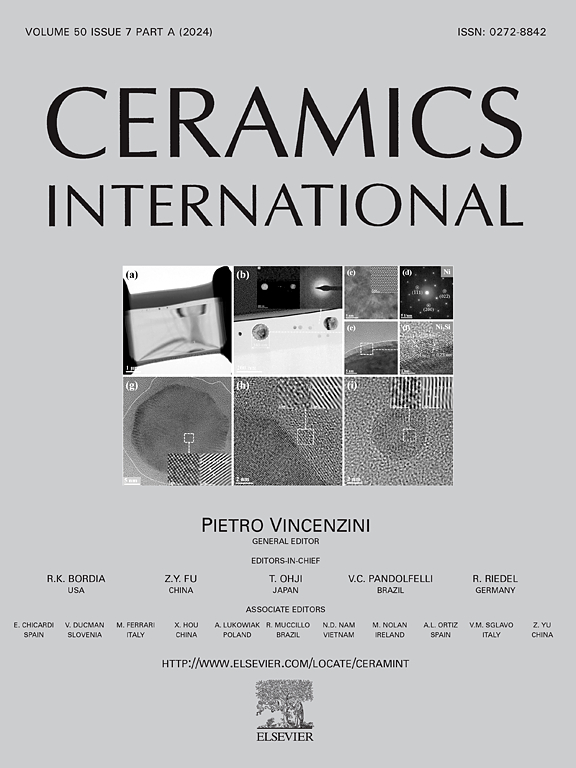Enhanced piezoelectric response and Curie temperature of BiFeO3-BaTiO3 by substituting PbTiO3 for BaTiO3
IF 5.1
2区 材料科学
Q1 MATERIALS SCIENCE, CERAMICS
引用次数: 0
Abstract
In this paper, ternary piezoelectric ceramics with PT gradually replacing BT, 0.65BF-(0.35-x)BT-xPT was successfully synthesized by traditional solid-state method. Achieving excellent performance when x = 0.08 (d33 = 220 pC/N, TC = 435 °C, Pr = 24.19 μC/cm2). To analyze the structural features of the ceramics, X-ray diffraction (XRD) and Raman spectroscopy were employed. Finally, the ferroelectricity of the sample was tested. The results indicate that the appropriate substitution of BT with PT results in a sample structure that coexists with the R phase and the pC phase at the MPB (Morphotropic Phase Boundary) structure, thereby achieving greater piezoelectric performance. With the increase of PT, the R phase increases and the content of pC phase decreases. The increase in the R phase leads to greater lattice distortion and a rise in the Curie temperature. An increase in PT causes a reduction in nanodomains and the formation of macrodomains. The domain structure with both macrodomains and nanodomains is also one of the reasons for the enhanced piezoelectric performance of the sample. A high Tc and a high d33 also indicate that BF-BT-PT ceramics have broad application potential at high temperatures.
用PbTiO3取代BaTiO3提高了BiFeO3-BaTiO3的压电响应和居里温度
本文以PT逐渐取代BT的三元压电陶瓷为材料,采用传统固相法成功合成了0.65BF-(0.35-x)BT- xpt。当x = 0.08 (d33 = 220 pC/N, TC = 435°C, Pr = 24.19 μC/cm2)时,性能优异。利用x射线衍射(XRD)和拉曼光谱分析了陶瓷的结构特征。最后对样品进行了铁电性测试。结果表明,适当的PT取代BT可使样品结构在MPB (Morphotropic phase Boundary)结构中与R相和pC相共存,从而获得更高的压电性能。随着PT的增加,R相增加,pC相含量减少。R相的增加导致更大的晶格畸变和居里温度的升高。PT的增加导致纳米结构域的减少和大结构域的形成。同时具有宏观畴和纳米畴的畴结构也是样品压电性能增强的原因之一。高Tc和高d33也表明BF-BT-PT陶瓷在高温下具有广阔的应用潜力。
本文章由计算机程序翻译,如有差异,请以英文原文为准。
求助全文
约1分钟内获得全文
求助全文
来源期刊

Ceramics International
工程技术-材料科学:硅酸盐
CiteScore
9.40
自引率
15.40%
发文量
4558
审稿时长
25 days
期刊介绍:
Ceramics International covers the science of advanced ceramic materials. The journal encourages contributions that demonstrate how an understanding of the basic chemical and physical phenomena may direct materials design and stimulate ideas for new or improved processing techniques, in order to obtain materials with desired structural features and properties.
Ceramics International covers oxide and non-oxide ceramics, functional glasses, glass ceramics, amorphous inorganic non-metallic materials (and their combinations with metal and organic materials), in the form of particulates, dense or porous bodies, thin/thick films and laminated, graded and composite structures. Process related topics such as ceramic-ceramic joints or joining ceramics with dissimilar materials, as well as surface finishing and conditioning are also covered. Besides traditional processing techniques, manufacturing routes of interest include innovative procedures benefiting from externally applied stresses, electromagnetic fields and energetic beams, as well as top-down and self-assembly nanotechnology approaches. In addition, the journal welcomes submissions on bio-inspired and bio-enabled materials designs, experimentally validated multi scale modelling and simulation for materials design, and the use of the most advanced chemical and physical characterization techniques of structure, properties and behaviour.
Technologically relevant low-dimensional systems are a particular focus of Ceramics International. These include 0, 1 and 2-D nanomaterials (also covering CNTs, graphene and related materials, and diamond-like carbons), their nanocomposites, as well as nano-hybrids and hierarchical multifunctional nanostructures that might integrate molecular, biological and electronic components.
 求助内容:
求助内容: 应助结果提醒方式:
应助结果提醒方式:


